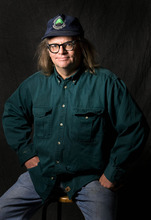This is an archived article that was published on sltrib.com in 2011, and information in the article may be outdated. It is provided only for personal research purposes and may not be reprinted.
The life of Utah underground artist and musician Bob Moss was a jigsaw puzzle, with the individual pieces scattered among family, friends and admirers.
Moss, 58, was known for his wood-burned folk art pieces that often incorporated the 19th-century Mormon Deseret Alphabet, as well as his quirky banjo and guitar recordings. He died Dec. 11 in his sleep at his parents' home in Bountiful. The official cause of death has yet to be established but is thought to be natural causes, his family said.
Although Moss was beloved by dozens of friends and artistic collaborators, no one person seems to have a complete picture of the artist. Every interview turns up a new facet to the man and his art. But the words "mysterious" and "fringe" crop up in nearly every conversation.
"Bob showed you what he chose to show," says his sister, Linda Hill. "He lived on the fringe of polite society, and he was fiercely independent and true to himself."
Moss was well-known in the Salt Lake City music and street scenes in the 1970s and 1980s, where he was considered an exceptional musician. But even in that context, Moss seemed to drift in and out of friends' lives.
"If you are involved in the arts community, over the last 30 years you ran into Bob. He was always there," says Clint Wardlow, who knew Moss from childhood and used Moss' music in videos. "He was a fringe guy. He was driven to do what he did, and his output of art was phenomenal."
Wardlow also used the word mysterious to describe his lifelong friend. "Once he was your friend, he was your friend. He seemed to come into your life at odd times — usually from the side and when you least expected it."
In an email from Cambodia, maverick filmmaker and icon of Salt Lake City underground culture Trent Harris ("Rubin and Ed"), wrote: "I can say that Bob was, without a doubt, a significant artist and a brilliant, unique voice. He was a first-rate artist. He followed his muse. I can say Bob was a huge influence on me and many others. Bob was a true pioneer, taking his art where others were afraid to go."
About five years ago, Moss' folk art, which he had been making for most of his life, began to catch on with a wider audience. Former Art Access Gallery executive director Ruth Lubbers hung 10 pieces of Moss' work as part of a 2010 show on Utah "outsider" art, a term that refers to works by self-taught artists who have an intuitive and compelling vision.
"Bob taught himself, and he didn't follow trends," says Lubbers, underscoring his privacy. "His art was for him."
Lisa Brady, proprietor of the Beehive Tea Room in downtown Salt Lake City, has been showing Moss' artwork since 2003. Right now, 20 of his works are hanging at the tea room for sale. Beyond being quirkily compelling, Moss' art has spread through Utah and beyond for two reasons: He was obsessively prolific, and he sold it cheap.
"Bob struggled with the whole concept that his art had value," Brady says of trying to set prices with Moss for his work. "He underestimated himself."
Joe Stetich, who recorded with Moss in the 1980s industrial band The Clocks, was shocked to learn Moss had died. "Deep in my heart I keep thinking that maybe this is a game he's playing and he's going to write a song about it or do something with it in his art," Stetich says.
Stetich says Moss was the only competent musician involved in The Clocks and brought folk music into the mix. "What a magical talent he had. Bob could play banjo, guitar and anything he picked up."
On his own, Moss covered Sinatra and Elvis songs on his banjo, another example to Stetich of his unique vision.
Moss never married and lived like a nomad in tiny apartments, cold-water studios and even the office of a storage facility in Clearfield, yet he always created art.
His mother, Cleo Moss, says she struggled most of her life to understand her son. "You worry for years," she says. "You just learn — I was a slow learner — to accept and love them for what they are."
Remembering Bob Moss
Bob Moss' music can be found on YouTube and purchased from Amazon at amzn.to/vwpeGS.
His art hangs in businesses around Salt Lake City, including the Beehive Tea Room, 12 West 300 South.
An extended interview with Bob Moss is available on Brian Staker's "The Awkward Hour." Find the link at: bit.ly/6fE7q
Bob Moss plays a Christmas carol downtown: bit.ly/tO9WfB
More • A celebration of Bob Moss' life will be held at noon Saturday, Dec. 17 at the Visual Art Institute, 2901 S. Highland Drive, Salt Lake City.



